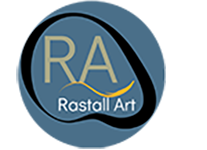British Abstract Painters from 1940 - 2000
Exploring British Abstract Painters from 1940-20002
While the spotlight often shines on the pioneering figures of British abstract art, it's essential to recognize the contributions of lesser known painters who played crucial roles in shaping the movement. From the post-war period to the turn of the millennium, these artists navigated their own creative paths, facing unique challenges and leaving their indelible mark on British abstract art. In this exploration, we delve into the creative changes, challenges, and constants of British abstract art through the painters lens from 1940 to 2000.
Post-War Dynamics: Navigating the Aftermath
Artist: Peter Thursby - Standing figures 1955 (Homage to Henry Moore)
Post World War II, British society underwent profound changes, and the art world was no exception. British Abstract Painters of the era found themselves grappling with the need to redefine artistic expression amidst the chaos of war's aftermath. While the pioneering figures like Ben Nicholson and Barbara Hepworth were laying the foundation for British abstract art, other painters were exploring their own interpretations of abstraction.
One challenge faced by British abstract painters during this period was the struggle to find their unique voice amidst the dominant narratives of the art world. However, this era also saw the emergence of innovative approaches to abstraction, with artists like William Scott and Bryan Wynter experimenting with new techniques and concepts that would shape the trajectory of British abstract art in the decades to come.
The Swinging Sixties: Embracing Experimentation
The 1960s marked a period of vibrant experimentation and artistic freedom for British abstract painters. As the swinging sixties swept across the nation, artists embraced bold colours, dynamic forms, and unconventional materials in their quest for artistic expression. Figures like John Hoyland and Albert Irvin emerged as leading voices of the era, pushing the boundaries of abstraction and challenging traditional notions of painting. It must be remembered that Hoyland, Irvin, Feiler & Canney may not have been the British Art scene ‘household names’ that they are now, 60+ years later.
British Abstract painters started exploring the new materials and were interested in the physical properties of new products like synthetic polymer paints (Acrylics) and their abilities to apply quick drying base coats and building multiple layers due to the paints quick drying properties. Techniques of waxes, splashes, stains and pouring were more accessible with these new artistic products than with the traditional tube of ‘Burnt Umber’ oil paint. However very traditional methods of grinding pigments and producing unique finishes also re-emerged or were re-imagined alongside the new artistic products, all striving for innovation in creativity.
Artist: Ewart Johns - Stack c.1951
One of the constants throughout this period was the spirit of innovation and experimentation that defined British abstract art. Painters and Printmakers continued to explore new techniques and styles, pushing the boundaries of abstraction and expanding the possibilities of painting, exploring constructivism & geometric abstraction. Despite facing challenges such as skepticism from critics and resistance from traditionalists, these artists remained steadfast in their pursuit of artistic excellence.
Rastall Art recently discovered an early 1950’s Ewart Johns painting on a discarded Edwardian canvas that had been turned inside out (an old oil landscape remains verso). Johns’ painting on the front of the discarded canvas gives the feeling of a world turning inside out towards modern abstraction, out with the old and quite literally ‘on’ with the new.
Conceptual Shifts: Redefining Abstraction
In the latter half of the 20th century, British abstract art underwent a conceptual shift, as artists began to explore new approaches to abstraction that challenged traditional notions of form and materiality. Painters like Patrick Heron and Victor Pasmore embraced conceptual abstraction, pushing the boundaries of their art, and exploring the interplay of colour, form, and space.
Artist: Patrick Venton - Low Tide, Beached Boats
One challenge faced by all British abstract painters during this period was the need to balance innovation with accessibility, as artists sought to engage viewers with their work while maintaining artistic integrity. However, this era also saw the emergence of ground-breaking works that challenged the conventions of painting and redefined the possibilities of abstraction in British art.
Legacy and Influence: The Enduring Impact
As we reflect on the creative changes, challenges, and constants of British abstract art through the painters’ lens from 1940 to 2000, we are reminded of the enduring impact of their contributions. While the pioneering figures of the movement may have captured the spotlight, many British painters played a crucial role in shaping the trajectory of British abstract art and expanding its possibilities.
British Abstract Art Collectors
Artist: Alexander MacKenzie - Untitled Abstract 1964/1965
For collectors and enthusiasts interested in acquiring works by British abstract painters, even the less known artists offer a rich tapestry of creativity and innovation. They create a unique area of discovery, contrast, and interest for the keen and informed British art collector. From galleries and exhibitions to online platforms and auctions, the works of these visionary artists continue to captivate audiences with their bold experimentation and innovative spirit.
As we celebrate the legacy of British abstract painters, let us not forget the contributions of those who played a crucial role in shaping the movement. Their innovative approaches to abstraction and commitment to artistic excellence continue to inspire artists and collectors alike, ensuring that the legacy of British abstract art remains vibrant and enduring for generations to come.
Rastall Art offers a wide selection on Modern British Art and European painters with a splash of British Abstract Painters for good measure.
Find more paintings here





